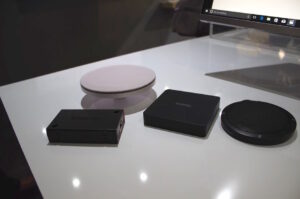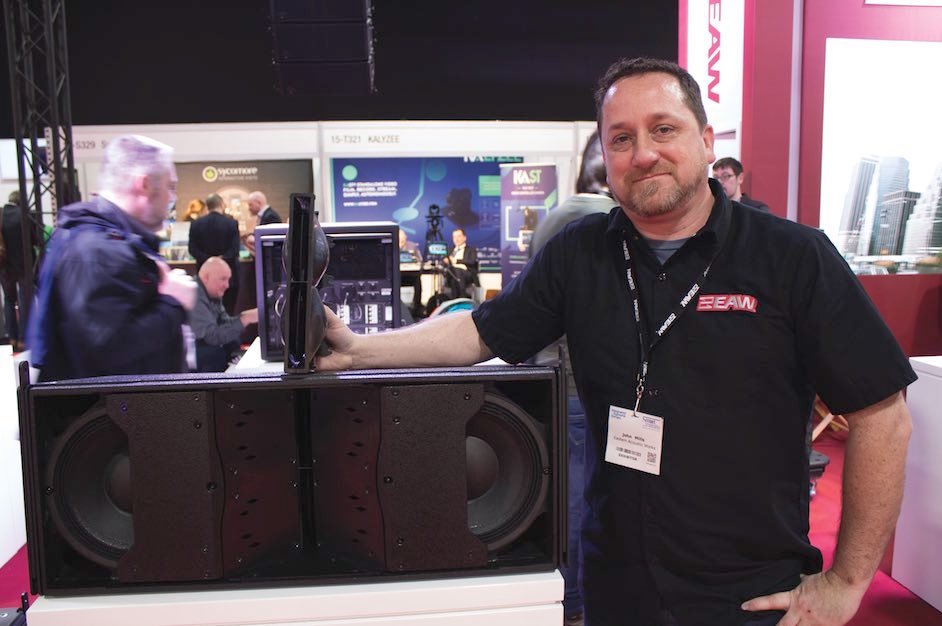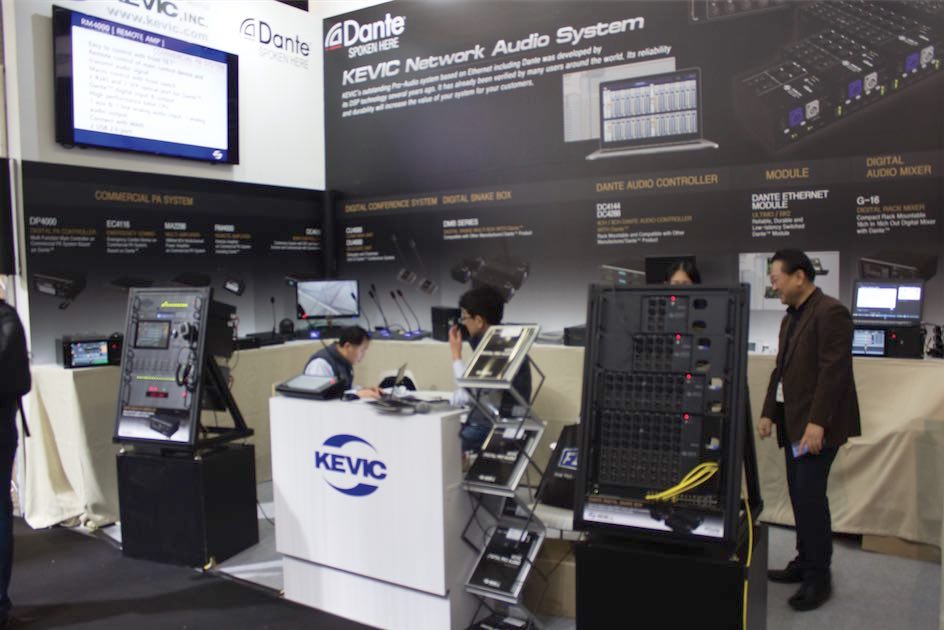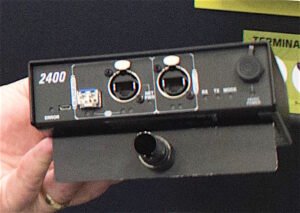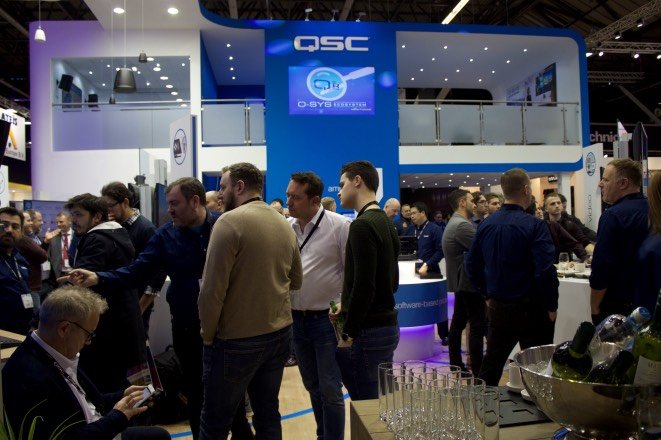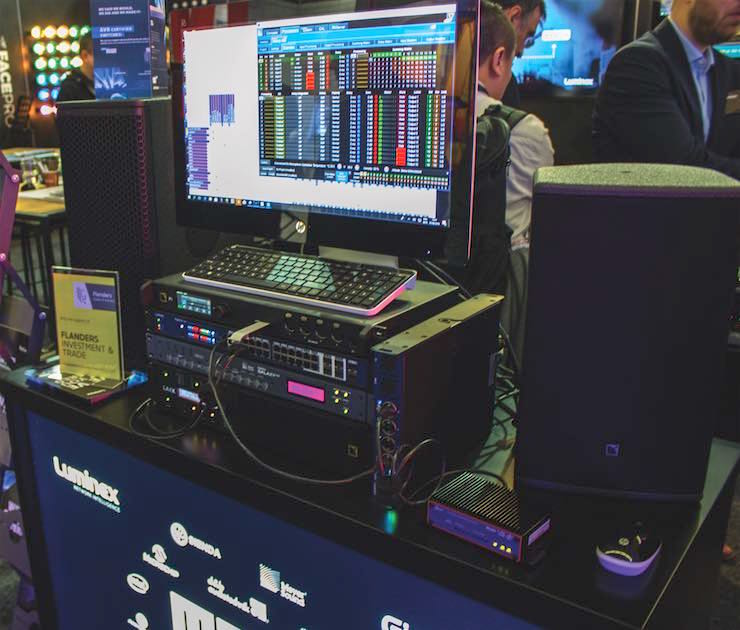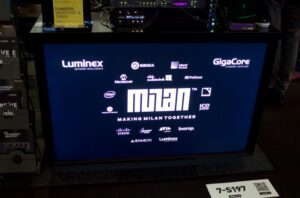News
13 Mar 2019
ISE 2019: Choose Your Own Adventure

Subscribe to CX E-News
ISE 2019
ISE 2019: Choose Your Own Adventure
by Jason Allen.
Amsterdam’s ISE is a huge, unwieldy beast of a show. Cramming it into 15 halls in the RAI Exhibition and Convention Centre is quite a feat, especially when you consider that it only has 11 halls to begin with. Jason Allen got lost in the labyrinth and reported back on what he found…
Attending ISE is like playing D&D. You stand in the corridor with two choices – turn left into one hall, or right into another. You roll the dice; left it is. Oh no! You’ve stumbled into the lair of ‘software-as-a-service’, where the matching suited minions of millennially-named companies like Zoosh! and Collab-ify! accost you with pamphlets touting their cloud based vapourware.
Had you turned right, you would have walked into the ‘Hall of Exactly What I Was Looking For’, boasting total interoperability over off-the-shelf Ethernet, and good coffee.
ISE is the first tradeshow that I have attended that is impossible for one person to see
or cover in its entirety. It attempts to be all things to all technicians – smart buildings, control, evac, video, LED, sound, networks, collaboration software – you name it, it’s here.
There was even an entire hall devoted to drones, which I didn’t even enter. And that’s the thing – you can’t see it all, so don’t even try. Make a list of everything important to you and concentrate on that. And try not to get lost.
There’s a decent sized lake at the rear of the RAI; I didn’t even find it until my last day.
With well over 1,300 exhibitors and more than 80,000 attendees shoehorned into a space never designed to cope with those numbers, the RAI built the world’s best marquee to cover the fact they’d sold 103% of the space available. A rumoured 183 exhibitors were turned away.
When the show finally relocates to the much more commodious Fira de Barcelona in 2021, it will be even broader in scope, with a number of lighting companies joining the few who have already crept in.
I’m not sure such an unfocussed show is a good thing for visitors or exhibitors. Sure, there’s a great vibe, and exhibitors get the warm fuzzies at the sheer volume of foot traffic, which got so dense on the second day it made walking the halls difficult. But the question they should ask themselves is; how many of these people are really there to see their thing? With the tech covering such broad areas, no one human mind can encompass them all.
But everyone’s there, including an impressive number of Antipodeans, which bodes ill for PL+S in a couple of years.
First – The Controversy
In the only bit of serious controversy to be had on the show floor, ClearOne announced that their ongoing legal stoush with Shure over the validity of their patent on ‘beamforming microphone arrays’ had been settled after the Patent Trial and Appeal Board ruled against Shure’s appeal to an earlier decision. This puts Shure’s MXA 910 ceiling array microphone, a major product for the company, in an unknown position, but likely to continue in production with some sort of financial agreement to be made with ClearOne. A similar product from Sennheiser seems unaffected, though this is most likely because they’ve already set up an agreement.
With the legals out of the way, ClearOne announced their own product in the space, the BMA CT, which includes built-in acoustic echo cancellation, noise cancellation, and beam selection, as well as a 2x10W into 8-ohm power amplifier. Rumour has it that many other companies were delaying releasing products into this space pending this decision, so it will be interesting to see what does (or doesn’t) get released in the aftermath.
On with The Show
Biamp
Biamp have decided that they want your entire signal chain, and showcased products that take you all the way from input to output. Their Parle microphones are beamtracking (hmmm, see above) and come in table or ceiling mount models. They’re compact, quite beautiful, and use four 90-degree tracking zones delivering 360-degree room coverage, using just one channel of acoustic echo cancelation. They boast that they need zero setup by the integrator, a claim Biamp are making across a lot of their new product range.
Biamp’s Tesira 1200 amps feature totally asymmetric power distribution, meaning you can define the power per output channel as you see fit across their range – one channel 10 watts, another 100 watts, and so on up until you get to the limit of the Tesira 1200.1’s 4-channel, 1200W or the Tesira 1200.2’s 4-channel, 2400W.
Biamp’s desono C-IC6 ceiling speakers can be deployed with the optional PoE+ AMP-450BP backpack amplifier, that mounts cleanly onto the back of the speaker, eliminating the need for multiple cable runs back to the rack. Each backpack amp powers up to seven additional desono speakers via Cat cable, creating a 100 percent termination-free installation, enabling a structured cabling crew to complete the entire above-ceiling audio rough-in for a conference room.
An innovative product that really got my attention was Crowd Mics. This system allows up to 1,000 WiFi connected devices(smartphones and tablets) to use their microphones via a free app to interact with a live event. Interfacing through a hardware unit called the ATOM, which connects to the audio system via balanced analogue or USB, the moderated system effectively turns everyone’s iPhone into a push-to-talk comms device. With latency of somewhere between 40 and 50 milliseconds, I’m curious to see it in action, and can’t think of an easier way to mic up several hundred people for Q&A at a corporate function.
Bose
Bose had a huge presence at the show, and ran the slickest press presentation I’ve ever attended at the neighbouring Novotel. They took an interesting tack – their introductory video explained they felt they’d been guilty of not being collaborative enough with their commercial customers, and vowed to make them part of every product development process from now on.
They then went on to run audio demonstrations of their new business music systems, DesignMax loudspeakers, commercial sound processors and controls, and the big surprise, their new ArenaMatch DeltaQ array loudspeakers and ArenaMatch Utility loudspeakers for outdoor installations.
Like their previous RoomMatch and ShowMatch array systems, you can swap waveguides for multiple horizontal and vertical coverage angles. Each box houses a 14-inch neodymium woofer and six Bose EMB2S titanium-diaphragm neodymium compression drivers. Weather-resistant features include a three-layer stainless steel grille, water-resistant woofer cone coating, industrial polyurethane exterior coating, and a molded input cover.
EAW
The first new product since EAW’s acquisition by RCF Group, the KF810P installation line array, was front and centre at EAW. It’s available in black or white, and wiring can be concealed, as can the rigging. A weather rated option allows for long term permanent installation in demanding environments backed by EAW’s full warranty. Each element is comprised of dual 3″ compression drivers fed through an all-new waveguide, four 5″ mid-frequency transducers and two 3″ voice coil high power 10″ LF drivers, delivering up to 145dB with accurate pattern control to 250Hz. A touring version is set to follow.
AoIP – Resistance is Irrelevant
Some interesting AoIP developments around the aisles:
Allen & Heath released a suite of Dante products – a 64×64 and a 128×128 card for dLive, the DT168 16 in 8 out stage box and the DT164-W 16 in 4 out wall-mount unit for installations.
Ghost Network were showing their FAST series ruggedised Ethernet switches for production, which of course can carry control protocols for lighting like Art-Net as well as AoIP. They’re basically HP switches with EtherCON added, but their software interface is slick and intuitive. Interestingly, they were boasting AVB capabilities, but aren’t Avnu Certified, which says a lot about customer interest in AVB right now and that’s a good thing for Milan adoption.
- Tascam MM
- Tascam MM – rear
Tascam have entered some interesting territory with their MM series of Dante I/O. Small, silver, ½ rack size and beautifully finished, they’re available as four analogue out, four analogue in, or two in/two out, all carrying four channels of Dante. Their unique proposition is that there’s DSP built in to each unit that can mix, EQ, process dynamics, automate level control, duck, route and reduce noise, making them capable of being the heart of small standalone or breakout sytems.
Dante has now hit the point where there are so many licensees not even Audinate really know who all of them are. One in particular jumped out at me – Korean brand Kevic. Pardon my ignorance, but I am totally unfamiliar with them. They had an entire stand of what looked like incredibly useful, industrial grade I/O boxes, paging, and DSP, all Dante enabled. Maybe if the first sentence on their website wasn’t “The 21st century is the time of leap when has been rapidly changing covering various fields of industry with digital technology,” more of us would know who they are.
Sometimes it’s the little things – L-Acoustics X4i is a 10cm deep coaxial 4” producing 116dB peak
Pliant
Pliant’s Gary Rosen took the time to give me the guided tour of exactly how their 2.4 GHz networked based comms system works around the common three WiFi channels. It’s quite ingenious, and involves repeating signals and longer-than-usual (in time, that is) square waves. With a 900 mHz product also available in Australia, Pliant are worth a serious look if you’re in the market for robust wireless comms with no need for a matrix.
- Pliant’s Gary Rosen
Powersoft
Definitely the most left-of-centre product and product demo I encountered at the show. Apart from making excellent power amps and DSP, Powersoft are also known for OEMing transducers.
Normally, transducers translate sound into movement that’s audible. In the case of the Powersoft Mover, they’re going for movement you feel. I stood on a floating platform with at least four of these things underneath it and put on a VR headset that ran a short animated video of a ball rolling down a jagged icefield, with accompanying sound effects and coordinated movement of the platform below me courtesy the Movers.
Now. I’m not as light as I used to be, and I was thrown around like a sock in a wind tunnel. I almost fell over several times. Embarrassing photos exist of these moments – see David Di Muzio at PAVT if you’d like a laugh at my expense. The target market for these little firecrackers is amusement parks, but I can see them going into high-end home theatre too.
Riedel
Following the success of their Bolero wireless comms, Riedel have released the standalone version for customers who want a small wireless comms network without the need for a matrix. It’s a license-based product, and can support 10 beltpacks per antenna and up to 100 antennas in a single deployment.
avt – The Forward Thinking Integrator’s View
avt were not only kind (and brave) enough to host a sizeable group of Aussies and Kiwis at a function with an open bar on the first evening of ISE, but also to take me on a personal tour of offerings from a number of its brands at the show. It provided a keen insight into how the industry’s hot tech trends are all combining to create completely new AV capabilities and products.
Every control vendor at ISE was touting native integration with one of the big conferencing soft codecs; Zoom, Google Hangouts, Skype for Business. The enormous Harman stable had everything that opens and shuts on their imposing stand, but their elegant AMX Modero touch panels stood out with their native Zoom integration – all controls are exactly the same as the Zoom interface on PC that customers are used to. This is just part of the puzzle that is the fabled ‘UX’ that all vendors are talking about
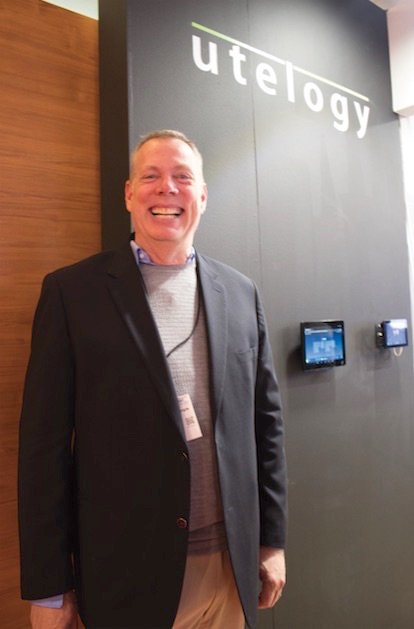
Utelogy’s co-founder and CTO Scott McGarrigle
Software based IP control is the sleeping giant of the AV industry. It’s the obvious way forward, but few companies want to talk about it. Not so avt with Utelogy, pushing ahead with what is emerging as the front runner in the field. Co-founder and CTO Scott McGarrigle explained most of the recent upgrades and expansions to the platform are all centred around data and analytics – who’s using what, when, where, how and why, and then making all of this easily interpretable and presentable within an organisation. There’s more than 80 metrics Utelogy can capture, with more on the way.
The new PanaCast 3 camera has upgraded to three 13 megapixel cameras outputting a 180 degree panoramic view at 4K. It can be powered over USB-C, and has a sleek new industrial design. All the smarts are in the adaptive capture and stitching, which happen in the device with no additional software. Plug and play with your favourite conferencing tool.
Tripleplay, which on the surface appear to be a digital signage service but are much more, have added Google Chromecast support for interactive IPTV, plus multicast stream support that can send four outs to a single player.
‘A’ adds ‘V’ at ISE
What better place than at the world’s largest AV show for ‘A’ to finally find its ‘V’? The first day of the Amsterdam mega tech-fest saw two titans of the AoIP world, Audinate and QSC, officially launch products that add video-over-IP to their market leading networked solutions.
Audinate kicked off with Dante AV – a new OEM board and product development suite that lets manufacturers easily add video transport to their audio solutions, or vice versa.
End-users and system admins already familiar with Dante will be completely at home with the way Dante AV handles video signal in Dante Controller – it’s all exactly the same matrix patching we all know, just with video channels labelled as such. The Dante AV board carries one video signal and eight channels of audio, allowing for all sorts of embedding and de-embedding flexibility.
Audinate’s Vice President of Marketing and Product Management Josh Rush explained that customers have been asking for video to be added to the Dante suite for years, and the company even demonstrated its capability to do this at least seven years ago. Without naming names, he assured us that we can expect a raft of new Dante AV product announcements from prominent audio and video manufacturers by the end of 2019.
 “There’s a few reasons it’s taken us this long to bring a video product to market,” explained Josh. “The first is general network infrastructure; we wanted to make sure it works on real-world network implementations.
“There’s a few reasons it’s taken us this long to bring a video product to market,” explained Josh. “The first is general network infrastructure; we wanted to make sure it works on real-world network implementations.
“Network adoption, bandwidth, and speed have had to grow to the point where they realistically support high quality video. The proliferation of 1 gigabit infrastructure means that’s now happened.”
“The second factor has been making sure we make the right play in this market space,” Josh continued. “The interoperability that Dante is known for needs to be the same
for video.
“We didn’t want to bring another codec to a fragmented market. We needed to build something that works in existing video ecosystems. So the Dante AV module is intended for companies that already have existing networked video products so they can add Dante transport, control, PandP and discovery.”
Meanwhile, QSC’s Q-SYS DSP, control, and hardware platform fulfilled the vision of its creator Rich Zwiebel by adding the first of its video endpoints, the NV-32-H. With three HDMI in, two HDMI out and eight channels of audio in and out, the unit is software defined as an encoder or decoder within Q-SYS.
In the already feature and option-rich Q-SYS environment, which just added Zoom integration directly from its touch panels without needing an external PC, video endpoints represent the last piece of the puzzle for QSC’s total domination of networked AV.

Caitlyn Sullivan
Caitlyn Sullivan is a Special Projects Engineer for QSC’s Q-SYS. She has written plug-ins for a huge variety of third-party devices for the Q-SYS platform, including the Atlona plug-in pictured.
Common to both Dante AV and the NV-32-H is the no-nonsense network and resolution specs; they both run on standard 1 gigabit networks and support 4K60 4:4:4. Staff at both stands emphasised they felt no need to force users onto 10 gigabit backbones, and no-one mentioned 8K, HDR, or any other ultra-hi-res formats. Both are going for simple boxes that allow those familiar with audio networking to feel completely at home.
MILAN – AVB LIVES!
Mea Culpa – it seems appropriate I apologise in Latin.
I have been cynical about AVB several times in print, and am happy to finally see what I thought what would never happen – a whole raft of new products, a robust and functional development alliance, and a software tool to unite it all.
Adamson kicked off before ISE with a major product announcement – its CS7p, the world’s first Milan-ready loudspeaker with redundancy. With 2400W, 80Hz to 18kHz response, dual 7”s and a 1.4” compression driver, it’s a workhorse that is equally at home in installs or production. It represents what is sure to be the first of many loudspeakers for the Milan environment. It was among many AVB/Milan products that were finally demonstrated working together at the show.
Over at the Luminex stand, a live demo with one of their switches at its heart saw an Adamson CS7p, Meyer Sound Galaxy, L-Acoustics LA4X amp and P1 processor, and an AudioScience Hono AVB mini I/O device all playing nicely, patched and monitored by what I’ve always seen as the final piece of the puzzle – Hive, an open source AVB patching, monitoring and configuration tool. Originally created by Avnu Alliance contributors for development purposes, it’s now available for download from Github.
Over at d&b audiotechnik, they too have jumped on board the Milan train, with their DS20 Audio network bridge, which provides an interface between d&b amplifiers and Milan. It incorporates 16 AES3 digital output channels, 4 AES3 digital input channels, and an integrated fully AVB-enabled 5-port network switch.
A stat that everyone with a Milan product on their stand kept quoting was its network latency – 53 nanoseconds. That’s right – nano. not micro, or milli. In audio, that’s no latency. The network is no longer a consideration, just how fast you can do an AD/DA conversion.
Milan finally adds all the pesky interoperability controls to AVB – important stuff like how
to control gain, phase, delay, and all of the other parameters that AVB always had the capability to handle, but needed to get everyone together in a room to agree on how. And inspiringly, I actually saw it happening.
In a conference room next to major Milan contributor Meyer Sound’s Hilton demo room, the Avnu Alliance Milan Working Group were doing just that – working. The main driver of all of this development, which is costing R&D time and money for the participants, is spatial audio.
The big four PA companies involved, d&b, L-Acoustics, Meyer Sound, and Adamson, all realise that they need a lot of channels of time-sensitive processing and distribution for spatial, and Milan represents the best way to get it without being beholden technologically or financially to Audinate.
The knock-on benefits of these heavyweights getting motivated to define interoperability over AVB should have serious market benefits across all networked audio and video products.
Meyer Sound – Spatial for The People of the Galaxy
Whisked away in unmarked black vans like we were being taken to a secret facility for questioning, the press and several important customers were transported to a function room at the Amsterdam Hilton, where Meyer Sound proceeded to blow our minds with two major new releases.
Touted as “the most innovative redesign of its point source loudspeakers since the introduction of self-powered systems more than two decades ago”, Meyer Sound’s new ULTRA X-40 is a new compact self-powered loudspeaker designed to revitalise the market space long-held by the UPA-1P.
Its driver heritage stems from the LEO family, with a concentric driver configuration using dual 8-inch neodymium magnet cone drivers coupled to a low-mid waveguide surrounding the single 3-inch diaphragm high-frequency compression driver.
The 110° x 50°Constant-Q HF horn is very easily rotatable; you basically grab it and twist. The onboard class D amplifier produces a total peak output power of 1950W, and
the whole thing weighs in at a ridiculously light (for Meyer Sound, anyway) 25 kg.
Preliminary performance specifications have it reproducing 60 Hz to 18 kHz, with linear peak SPL of 130.5 dB measured with M-Noise, Meyer Sound’s new more ‘musical’ test signal.
The demonstration of a pair at FOH was stunning.
This is a beautiful, beautiful box, with high end that I could listen to for days without fatigue. We listened both with and without subs, and a pair of these with subs could easily fill a 500 pax room with almost no processing, and still have headroom for days.
This would have been a big enough audio deal by itself, but then Meyer Sound upped the ante with a demonstration of Spacemap Live, their new spatial audio solution designed for mixing music on the fly.
Running on their existing Galaxy processors, Spacemap Live enables sound designers and mixers to define ‘Spacemaps’ of multiple loudspeakers at will, and then pan sources seamlessly between them, with tactile control from the Spacemap app, demonstrated in this instance on multiple iPads.
It’s a new implementation of what Meyer Sound (and previously LCS) have been doing for years with companies like Cirque du Soleil, and other major theatrical productions.
It’s radically different to both L-Acoustic’s L-ISA and d&b audiotechnik’s Soundscape in that it allows total freedom of loudspeaker type and placement. It’s really up to the sound designer to make the coverage work, while Spacemap Live provides a rock-solid tool kit to move sound with beautifully managed panning across any group of outputs.
The phase coherence of a complete rig of Meyer Sound loudspeakers certainly helped the effect, as Steve Ellison, Director of Spatial Sound for Meyer Sound, mixed tracks in real time at FOH.
I particularly liked the matrix view available in Galaxy which lets you get a view of levels across all of your matrix outputs, giving you visual reassurance your multi-channel panning is working. Spacemap Live has been tested with up to four Galaxy processors connected via AVB, though that’s by no means the upper limit.
“We wanted to create a spatial mixing interface that is quick and intuitive,” said Steve Ellison.
“We’ve been using OSC for these kinds of things for a long time, and this Spacemap prototype uses it, though that doesn’t mean the final product will. It’s designed to be quick, configurable
and manageable.
“You want to be thinking about music when you’re mixing music, not spreadsheets or CAD.”
Curiously, the genesis of Spacemap Live can be traced back to Steve Ellison’s adventures in Canberra in the mid 1980s.
“In 1986 I had been working for a helicopter company and had the opportunity to go to Australia, where I worked part time at ANU doing computer programming,” he explained.
“I was making computer music using an early Mac. I knocked on doors at the Canberra Institute of the Arts, which is now part of ANU, and found a group called Floating Exceptions that had built their own geodesic dome with 16 loudspeakers and a few subs, creating a portable multi-channel performance space.
“There wasn’t anything on the market that could do what they needed, so they had to build everything themselves.”
“While I was working with them, we had to figure out how to move sound around,” Steve continued.
“The prevailing technique at the time, put forward by John Chowning and others, used calculations of the distance between loudspeakers to determine fades up and down, but that was inefficient and computationally expensive.
“I figured out a way to optimise panning and fades using three loudspeakers, which was much more efficient. It evolved over the years with LCS, then Meyer Sound. Finally, in 1993, the technology caught up and we had a digitally controlled analogue matrix; the first LCS system.
“The whole foray into developing software for multi-channel started there. For me, it’s gratifying to see a technique and algorithm that started in music, which was then adopted and embraced by theatre, finally having come back to live music.”
Spacemap Live is being pitched as an easy addition to the existing live music environment.
FOH engineer Dennie Miller (21 Pilots, Miguel) talked us through a Spacemap Live mix he’d made of an existing live recording of one of his artists, changing none of his bussing or processing from his existing SD7 show file.
He had some interesting observations on its artistic use in the standard rock show environment, like being careful not to do any wild panning with instruments that are obviously located on stage (like drum kits) and instead concentrating on playback and electronic elements for more immersive effects.
Spacemap Live will be a firmware upgrade to existing Galaxy processors, with no hardware modification required. It remains to be seen if this will be at an extra cost, or with an ongoing license fee.
From CX Magazine – March 2019.
CX Magazine is Australia and New Zealand’s only publication dedicated to entertainment technology news and issues – available in print and online. Read all editions for free or search our archive www.cxnetwork.com.au
© CX Media
Subscribe
Published monthly since 1991, our famous AV industry magazine is free for download or pay for print. Subscribers also receive CX News, our free weekly email with the latest industry news and jobs.


